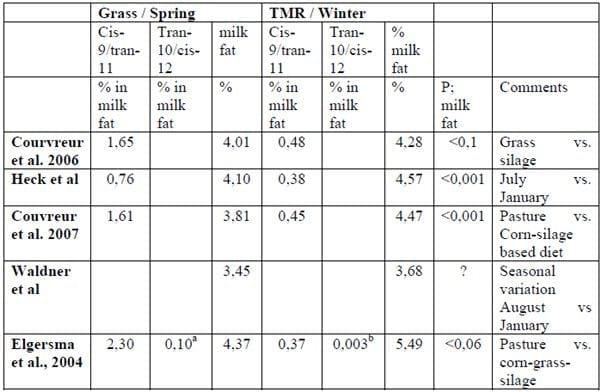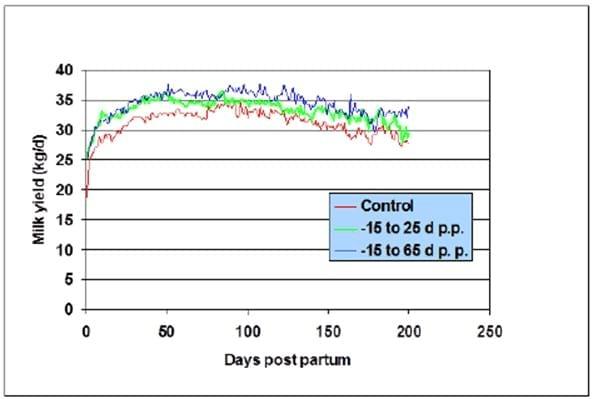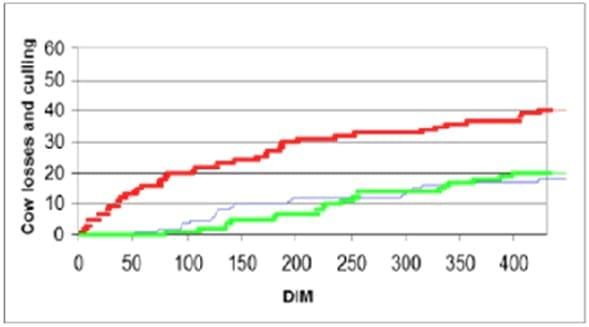Conjugated Linoleic Acid (CLA) is supporting yield, health and fertility of the dairy cow
Published: March 7, 2014
By: Arnulf Tröscher (BASF)
Abstract
During natural grazing of pasture, ruminal bio hydrogenation of unsaturated fatty acids leads to the formation of intermediates which are known as CLA (conjugated linoleic acid) isomers. Some of them, like the trans-10/cis-12 isomer are responsible for the observed reduction on milk fat concentration under grazing conditions. Supplementing silage-concentrate diets of transition dairy cows with CLA will adjust the milk fat content to a pasture-like level. The glucose sparing effect from reduced milk fat synthesis is modulating tissue mobilization. As a consequence, cows will leave the fresh pen in better condition and higher milk yield.
Introduction
On the nature of CLA (trans-10/cis-12 and other isomers) in dairy cow diets. Dairy cows like other terrestrial mammals have a requirement for poly unsaturated fatty acids (PUFA) in the synthesis of phospholipids to maintain membrane fluidity and as a substrate for synthesis of key endocrine regulatory compounds including prostaglandins and eicosanoids. Part of the requirements for unsaturated fatty acids in the dairy cow are met through the action of Δ9-desaturase on saturated and unsaturated fatty acids substrates. In lactating cows the mammary gland is the major site of desaturation, with a significant contribution from adipose and the intestinal mucosa (Palmquist et al., 2005). Stearic and palmitic acid are the major substrates, but other fatty acids including trans-7 18:1 and trans-11 18:1 VA (vaccenic acid) are also desaturated to yield trans-7, cis-9 CLA and cis-9, trans-11 RA (rumenic acid), respectively. Endogenous synthesis is the major source of RA in milk fat and the sole source of trans-7, cis-9 CLA in bovine milk. Ruminant tissues are relatively abundant in trans fatty acids and isomers of CLA indicating that host ruminant metabolism has evolved to utilise intermediates formed during the biohydrogenation of dietary fatty acids in the rumen for functions including phospholipid synthesis.
Under pasture based milk production, cows can be expected to synthesize high amounts of CLAs including trans-10, cis-12 CLA and cis-9, trans-11 RA. Thus far potential benefits of RA on host metabolism in dairy cows have not been reported. However, milk fat RA concentrations are higher at pasture than from cows fed conserved forages, effects that are not simply explained by differences in PUFA intake (Chilliard et al., 2007)1. A recent study by Mohammed et al. (2009) confirmed that milk RA content was higher at pasture than from cows fed grass silage or zero-grazed).
There are numerous results published, which show that cows on pasture produce milk with lower butter fat level than the same cows on a silage/concentrate based diet will do. These findings are explained as the higher production of bio-hydrogenation intermediates for cows on pasture. Elgersma et al., 20042 had cows on pasture and changed them within 2 weeks to a TMR diet of silages and concentrate of the same crude nutrient contents. During this change, a decrease in trans-10/cis-12 in milk fat and an increase in milk fat was noted.
Similar findings were reported by Waldner et al, Couvreur et al (2007), Heck et al (2009) and Couvreur et al (2006) and all are summarized in Table 1
Table 1: Literature review on differences in CLA and milk fat concentrations due to shift from grass to silage/winter feeding

However, with the pressure to increase the size of herds to maintain profitable milk production and limited availability of land, producing milk from pasture becomes increasingly less viable. There are of course exceptions to this trend, including New Zealand and Ireland where grazing is central to milk production. In other countries, indoor housing and feeding of diets based on conserved forages is often the norm, which combined with the drive to expand herd sizes will become more commonplace. As a result, milk fat CLA content can be expected to decline consistent with lowered ruminal production of this nutrient by the cow.
Part of this shortfall could be met by supplementing the diet with oilseeds and plant oils (Polan et al. (1964), Shingfield et al. (2004), Chilliard et al. (2007)). A recent meta-analysis (Glaser et al., 2008), concluded “Total CLA percentage was linearly increased by all supplements except rapeseed as seeds (coefficient for protected rapeseed is given for the record, based on one experiment), mostly by soybeans, followed by sunflower seed, rapeseed oils, and linseed.” Mean milk RA content was increased from 0.58 to 1.12 and 1.72 g/100g total fatty acids by dietary supplements of sunflower seeds and sunflower oil. Milk fat trans-10, cis-12 CLA concentrations are also increased by dietary lipid supplements, but in general these need to be fed along with increases in the amount of concentrates in the diet to increase ruminal formation and its concentrations in milk fat. Attempting to increase the supply of trans-10, cis-12 CLA available to the dairy cow through alterations in diet composition does not come without certain disadvantages. Feeding high concentrate diets containing plant oils often lower fiber digestion in the rumen and feed intake, thus lowering energy supply to the animal and inducing unpredictable decreases in milk fat percentage (Glaser et al. (2008), Shingfield and Grinarii (2007); Palmquist (2009), Shingfield et al. (2007), Lock and Shingfield (2007), Bauman and Griinari (2003). Therefore, adjusting milk fat concentration by dietary supplements of trans-10, cis-12 CLA might be a decision which not only has proven to be very beneficial (e.g. shorter days open, by de Veth et al., (2009)) for the cow but also a logical consequence if one tries to balance a modern silage/concentrate diet with all nutrients that were provided by pasture.
In summary, grazing cows are not only consuming crude nutrients, minerals and vitamins but also fatty acids which are bio-hydrogenated in the rumen to a multitude of intermediates that are absorbed in the small intestine, providing, inter alia, reduction in milk fat concentration which are typically 5 to 20% lower than under silage-concentrate conditions. Those intermediates are conjugated linoleic acids which are characteristic in pasture based milk. CLA supplements are suited to balance out modern diets of cows that don’t go on pasture. The similar milk fat reduction which occurs while feeding CLA as a supplement is no adverse effect but a proof that the CLA supplementation makes silage-concentrate diets more adequate to a pasture diet and its specific nutritive effects.
What is the nutritive effect of CLA?
As described above, the trans-10/cis-12 CLA isomer is known for its milk fat reducing effect. Details have been described by Baumgard et al. (2000) and Baumgard et al. (2002). The same effect has natural grazing on pasture. Since milk fat synthesis in the mammary gland requires glucose (Palmquist (2006) (ca. 30 g/l milk) as reducing equivalences and for the glycerol backbone of the triglycerides, a reduction in milk fat concentration likely saves glucose which should result in higher plasma glucose levels. This increase was in deed demonstrated in 3 trials with CLA and details are listed in Table 2.
Table 2: Effect of the feeding of Lutrell on the level of plasma glucose in week 2 after calving as compared to the control groups. Values are taken from papers of 3 different trials.

In summary, the CLA trans-10, cis-12 by way of milk fat reduction like under natural grazing, is able to increase the level of plasma glucose shortly after calving, supporting the hypothesis that the supplementation of trans-10, cis-12 CLA in effect spares glucose.
What is the benefit of a glucose saving effect for the cow?
Since the transition dairy cow in negative energy balance has only a limited availability of glucose, a post-ruminal supplementation of glucose or glucogenic precusors is considered helpful to stabilize the health of such cows. Al-Trad et al (2009) summarize this in the introduction of their paper on a glucose infusion trial: To minimize the adverse consequences of glucose shortage, nutritional strategies to improve glucose homeostasis are an important area of dairy research. In deed the results of the trial by Al-Trad et al (2009) show, that the infusion of glucose led to an increase in adipose tissue. And Ahmadzadeh et al. (2012) have shown that a high glucose level in the first weeks after calving is an excellent predictor for early ovulation.
Many trials with CLA-products in early lactation cows showed that these cows better maintained their body condition score (BCS) after calving, presumably because of the potential for energy conservation. However these findings were not always significant since body condition scoring is a rather subjective measure to take (Hammon et al. (2011), Bernal-Santos et al. (2003). Hutchinson et al (2012) and von Soosten et al (2012) found significant differences . In a comparative slaughter trial, von Soosten et al (2012) were looking whether CLA would change the body composition of transition heifer by day 42 of lactation.
There were numerical differences for most parameters in favour of the CLA-cows. For the sum of fat and protein, Lutrell-cows only mobilized 10,7 kg in the first 42 days after calving vs. 21,3 kg for the control group (P<0.073). Also the energy mobilization was positively affected by Lutrell feeding (p<0.108). Odens et al. (2004) found similar results in terms of BW change after calving. CLA cows had a significantly lower loss of BCS and BW. Shingfield et al (2005) used a casein formaldehyde protected CLA. They also found a significant increase in tissue energy retention.
Table 3: Change in BW and empty body mass (EBM), and mobilization (negative values) and accretion (positive values) of body fat and protein with assessment for energy metabolism from 1 to 42 DIM of cows fed the control (CON) diet or conjugated linoleic acid (CLA)-supplemented diet (means ± SE)

In summary, an additional supply of glucose to the early lactation cow helps to save body condition and is therefore a good predictor for early ovulation. The feeding of CLA during the same lactation phase has been shown to increase plasma glucose levels and subsequently reduce the mobilization of body tissue like protein and fat.
Beyond body condition development
CLA’s effect on glucose and subsequent maintenance of body condition explain the positive effects of CLA on milk yield, health and reproduction, which were reported earlier e.g. from a trial in Mexico by Jasso et al. (2009). After feeding the product from 15 days prior until 25 / 65 days post calving, CLA cows had ca. 4 kg more milk, 57 days less open and over a 400 day period losses of only 20 cows while the control group lost 40, of a total of 150 cows per group.



Conclusion
In natural grazing of pasture, ruminal bio-hydrogenation of unsaturated fatty acids leads to the formation of intermediates which are known as CLA isomers. Some of them, like the trans-10/cis-12 isomer are responsible for the observed lower milk fat concentration under grazing conditions. Adjusting milk fat concentrations to grazing levels in the early lactation dairy cow with supplemental trans-10/cis-12 CLA has been shown to increase plasma glucose levels, which can be considered a sparing effect due to the reduced nutritional glucose requirement for milk fat synthesis. Since glucose is often the most limiting factor in early lactation, an increase in plasma glucose levels with the feeding of CLA has been demonstrated to help the cow managing energy demands in this period. This explains the often reported increase in milk yield as well as improvements in health and reproductive performance.
Literature
Ahmadzadeh A., J. Spencer, B. Shafii, C. Johnson, J. Dalton, K. Carnahan, and S. Reeds (2012). Investigation of the relationship between resumption of ovarian cyclicity and plasma nutritional markers in lactating dairy cows J. Dairy Sci. 95, Suppl. 2; M204.
Ahmadzadeh A., J. Spencer, B. Shafii, C. Johnson, J. Dalton, K. Carnahan, and S. Reeds (2012). Investigation of the relationship between resumption of ovarian cyclicity and plasma nutritional markers in lactating dairy cows J. Dairy Sci. 95, Suppl. 2; M204.
Al-Trad B., K. Reisberg , T. Wittek, G. B. Penner , A. Alkaassem , G. Gäbel , M. Fürll , and J. R. Aschenbach (2009). Increasing intravenous infusions of glucose improve body condition but not lactation performance in midlactation dairy cows J. Dairy Sci. 92 :5645–5658
Bauman DE and Griinari JM (2003). Nutritional regulation of milk fat synthesis. Annual Review of Nutrition 23, 203-227
Baumgard LH, Matitashvili E, Corl BA, Dwyer DA & Bauman DE (2002). Trans-10, cis-12 conjugated linoleic acid decreases lipogenic rates and expression of genes involved in milk lipid synthesis in dairy cows. J. Dairy Sci. 85 2155–2163.
Baumgard LH, Corl BA, Dwyer DA, Saebo A & Bauman DE ( 2000). Identification of the conjugated linoleic acid isomer that inhibits milk fat synthesis. Am. J. Physiology. 278 R179–R1841.
Bernal-Santos,3 J. W. Perfield II, D. M. Barbano, D. E. Bauman, and T. R. Overton (2003). Production Responses of Dairy Cows to Dietary Supplementation with Conjugated Linoleic Acid (CLA) During the Transition Period and Early Lactation. J. Dairy Sci. 86:3218–3228.
Csillik Z., V. Faigl, M. Keresztes, E. Galamb, A. Tröscher, H. Fébel, M. Kulcsár, F. Husvéth, G. Huszenicza (2011). Lipid-encapsulated conjugated linoleic acid (CLA) supplementation: Effects on changes in energy metabolism of the transition cow. Oskar-Kellner-Symposium, Dummerstorf, Germany.
Couvreur, S. C. Hurtaud, P. G. Marnet, P. Faverdin, and J. L. Peyraud (2007). Composition of Milk Fat from Cows Selected for Milk Fat Globule Size and Offered Either Fresh Pasture or a Corn Silage-Based Diet J. Dairy Sci. 90:392–403.
Couvreur, S. C. Hurtaud, C. Lopez, L. Delaby, and J. L. Peyraud (2006): The Linear Relationship Between the Proportion of Fresh Grass in the Cow Diet, Milk Fatty Acid Composition, and Butter Properties. J. Dairy Sci. 89:1956–1969.
Chilliard Y, Glasser F, Ferlay A, Bernard L, Rouel J and M. Doreau (2007). Diet, rumen biohydrogenation and nutritional quality of cow and goat milk fat. European Journal of Lipid Science and Technology 109:828-855.
de Veth, D. Bauman, W. Koch, G. Mann, A.M. Pfeiffer, and W. R. Butler (2009). Efficacy of conjugated linoleic acid for improving reproduction. A multi-study analysis in early-lactation dairy cows J. Dairy Sci. 92:2662–2669.
Elgersma A., G. Ellen, H. van der Horst, H. Boer, P.R. Dekker, S. Tamminga (2004). Quick changes in milk fat composition after transition from fresh grass to a silage diet and effects on consumer health benefits. Animal Feed Science and Technology, 117,13-27.
Hammon H. M., Kristin Hötger, Solvig Görs, Maria Becker, Claudia Weber, A. Tröscher, Cornelia C. Metges (2011) Conjugated linoleic acid (CLA) supplementation around calving affects glucose metabolism in dairy cows. Dairy Sci. Meeting New Orleans 2011, Abst. T316.
Heck, J.M.L.; H.J.F. van Valenberg, J. Dijkstra, A.C.M. van Hooijdonk (2009). Seasonal variation in the Dutch bovine raw milk composition. J. Dairy Sci. 92: 4745-4755.
Hutchinson I. A., A. A. Hennessy , R. J. Dewhurst , A. C. O. Evans , P. Lonergan , and S. T. Butler (2012). The effect of strategic supplementation with trans-10,cis-12 conjugated linoleic acid on the milk production, estrous cycle characteristics, and reproductive performance of lactating dairy cattle. J. Dairy Sci. 95 :2442–2451.
Jasso, J., B. Cousins and A. Troescher (2009). Lutrell Pure, un innovador complemento nutricional para vacas lecheras. BASF report1.
Lock AL and KJ Shingfield (2004). Optimising milk composition. In Dairying – using science to meet consumers’ needs (eds E Kebreab, J Mills and DE Beever), pp. 107-188. British Society of Animal Science, publication no. 29, Nottingham University Press, UK.
Mohammed R, CS Stanton, JJ Kennelly, JKG Kramer, JF Mee, DR Glimm, M O’Donovan and JJ Murphy, (2009). Grazing cows are more efficient than zero-grazed and grass silage-fed cows in milk rumenic acid production. J. Dairy Sci. 92:3874-3893 (Odens L. J., R. Burgos, M. Innocenti, M. J. VanBaale, and L. H. Baumgard (2007). Effects of Varying Doses of Supplemental Conjugated Linoleic Acid on Production and Energetic Variables During the Transition Period J. Dairy Sci. 90:293–305.
Palmquist DL, AL Lock, KJ Shingfield and DE Bauman ( 2005). Biosynthesis of conjugated linoleic acid in ruminants and humans. In Advances in Food and Nutrition Research (ed. S. Taylor), volume 50, pp 179-217. Elsevier Academic Press, US.
Palmquist, D (2006). Milk Fat: origin of fatty acids and influence of nutritional factors thereon. In: Advanced Dairy Chemistry; Vol. 2; Lipids. Springer Science edit. By Fox and McSweeney. 3rd edition.
Palmquist DL( 2009). Omega-3 fatty acids in metabolism, health, and nutrition and for modified animal product foods. Professional Animal Science 25:207–249.
Shingfield K. J. , D. E. Beever C. K. Reynolds, S. K. Gulati, D. J. Humphries, B. Lupoli, G. Hervas, and M. J. Griinari. Effect of rumen protected conjugated linoleic acid on energy metabolism of dairy cows during early to mid-lactation. J. Dairy Sci. Vol. 87, Suppl. 1
Shingfield KJ, Ahvenjärvi S, Toivonen V, Vanhatalo A and Huhtanen P ( 2007). Transfer of absorbed cis-9, trans-11 conjugated linoleic acid into milk is biologically more efficient than endogenous synthesis from absorbed vaccenic acid in the lactating cow. Journal of Nutrition 137:1154-1160.
von Soosten D, U. Meyer , M. Piechotta , G. Flachowsky , and S. Dänicke (2012). Effect of conjugated linoleic acid supplementation on body composition, body fat mobilization, protein accretion,and energy utilization in early lactation dairy cows J. Dairy Sci. 95 :1222–1239.
Waldner DN, Stokes SR, Jordan ER and Looper M. Managing milk composition: normal sources of variation. Oklahoma State University.
This paper was presented at the 12º Congreso Internacional de MVZ especialistas en Bovinos de la Comarca Lagunera, Mexico, November 2012.
Related topics:
Authors:
BASF México
Recommend
Comment
Share

Would you like to discuss another topic? Create a new post to engage with experts in the community.





.jpg&w=3840&q=75)